How To Use Sperry Voltage Tester
How to Employ Cheap Electrical Testers
Three testers make electrical work safer and easier — and for less than $20, you tin can ain them all.
Introduction
We'll show y'all how to use cheap electrical testers to make electric work safer and easier. Nosotros embrace 3 testers — a non-contact voltage tester, a circuit tester and a continuity tester. Yous tin purchase all three at home centers for almost $20. Then yous'll never have to worry about getting shocked once more.
Tools Required
A non-contact voltage tester, a circuit tester and a continuity tester — they cost less than $20 altogether at dwelling house comeback centers. Hither, we explicate why that'south money well-spent.
Projection step-past-footstep (13)
How to Test Electric Outlets and How to Test a Lite Switch with a Not-Contact Voltage Tester
- This is the safest tool to confirm that electrical power is off, even before you lot touch a wire.
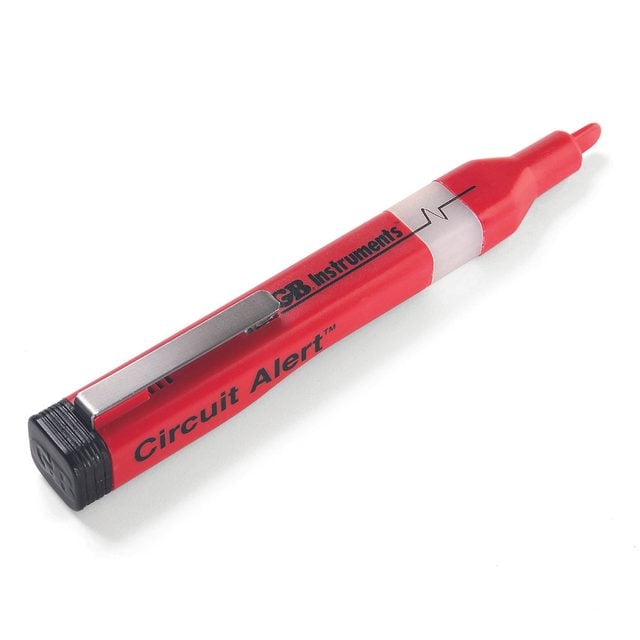
Step ii
Examination the Receptacles
- Test receptacles with an electric outlet tester to make sure they're off before removing them.
- Turn the ability off to the outlet.
- Shove the electrical outlet tester olfactory organ into the narrow (hot) slot of the receptacle.
- Note: The tester will light and chirp continuously if the power is however on.
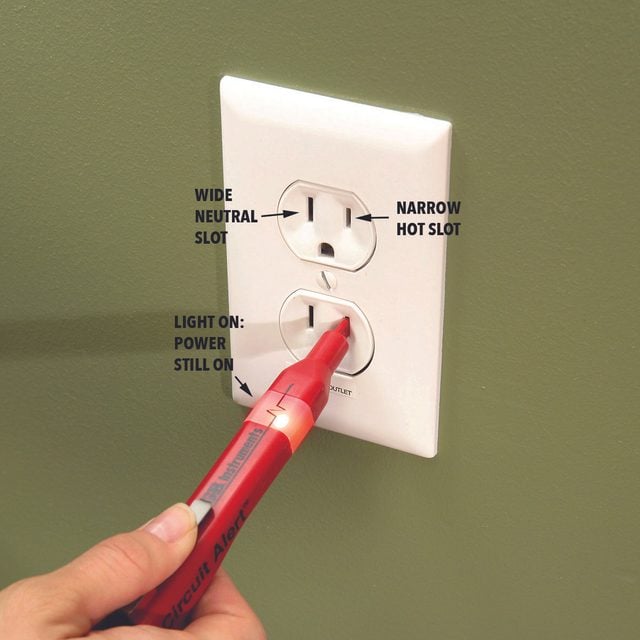
Stride 3
Test for Hot Wires
- Exam for hot wires inside a receptacle.
- Pull out the receptacle.
- Push the electric outlet tester deep into the box to cheque for other hot wires.
- If you find them, turn them off at the primary console.
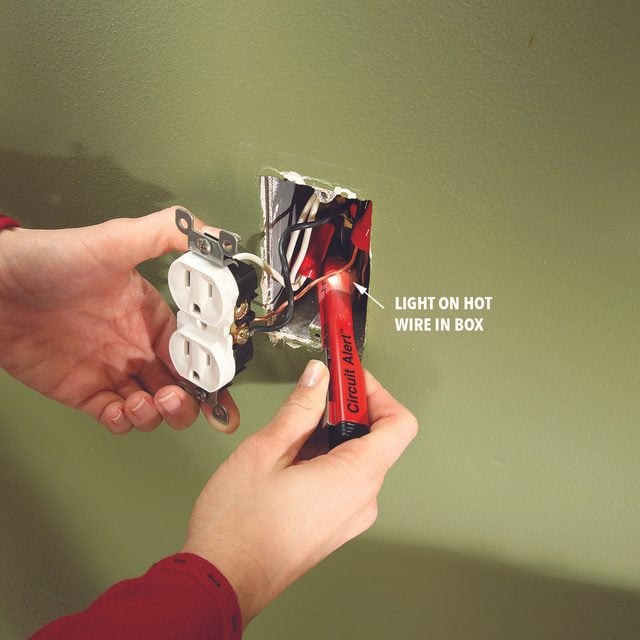
Stride 4
Test Switches
- Exam switches to make sure the ability is off.
- Turn the power off at the primary console.
- Remove the cover plate.
- Push the tester nose shut to i, then the other, of the two switch wire terminals to see if either wire is still hot.
- If there are no live wires, unscrew the switch, pull information technology out and test all other wires in the box.
- If there are multiple switches, check them all.
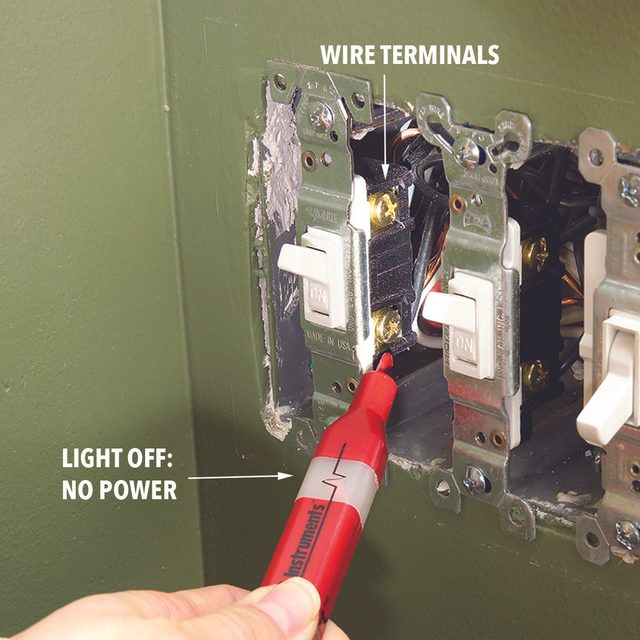
Step 5
Test Light Fixtures
- Remove the bulb and test the contact in the lesser of the socket for voltage.
- Brand sure the light switch is in the 'on' position.
- If no voltage is present, unscrew the fixture from the electrical box.
- Pull information technology out and test the other wires in the box as before.
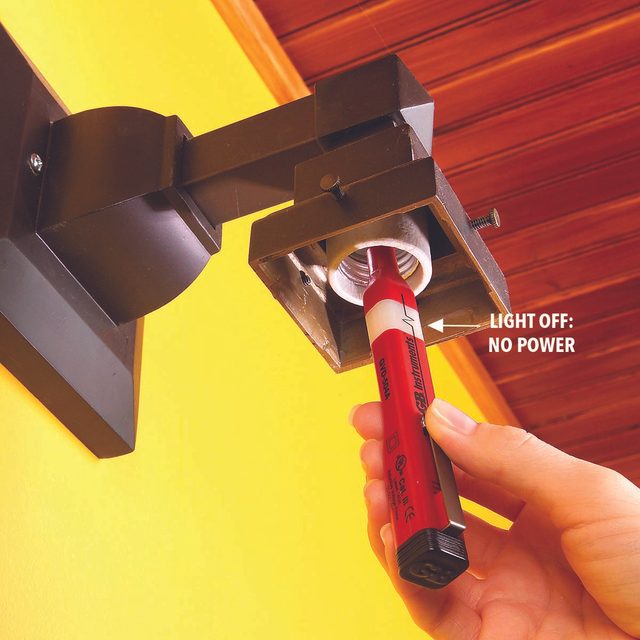
Step 6
Test Cables
- Use the electrical outlet tester to identify hot cables.
- Notation: This examination method is for plastic-sheathed cables simply, so that you lot can plough those circuits off before sawing or drilling around them.
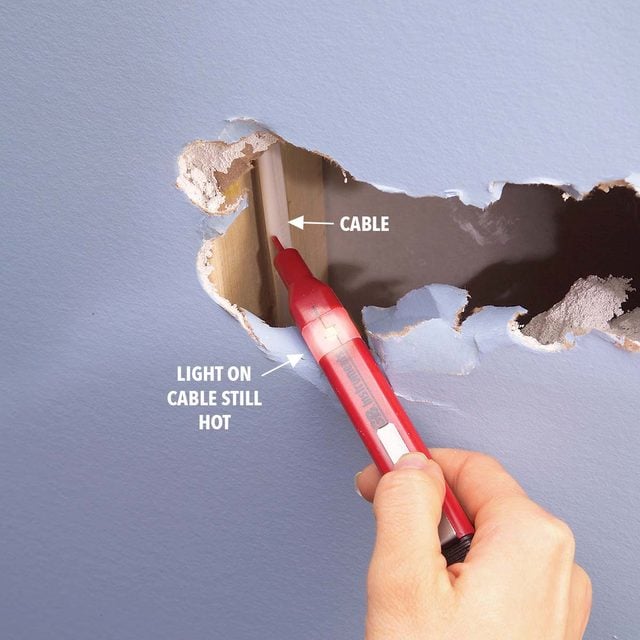
Cheque Your Batteries
This electrical outlet tester is powered by pocket-size batteries, and then make sure it works before using information technology. Shove the tip into the slots of a receptacle that'due south live, hold it near a plugged-in lamp cord or hold it confronting a calorie-free bulb that'southward on. With about testers, you'll encounter a series of flashes and hear continuous chirps that indicate voltage. Testers may wink and chirp at other times, merely without the continuous pattern that indicates a hot wire.
Step 7
Use a Circuit Tester to Test for Adept Grounding
- This is the almost reliable tool to tell if a excursion is complete.
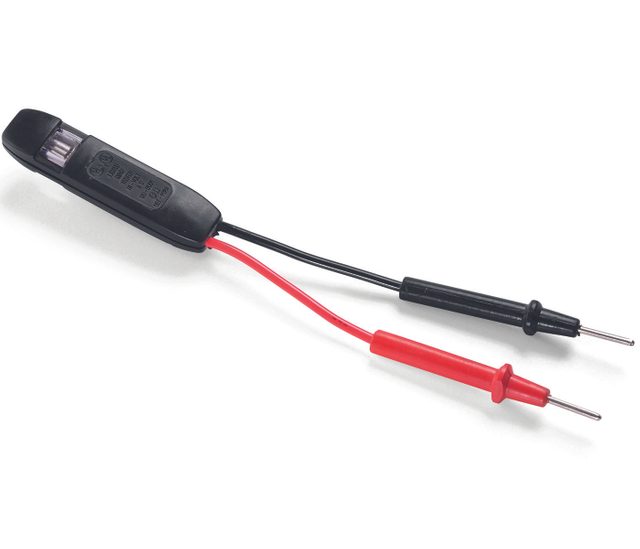
Step eight
Examination Footing Wires
- Disconnect and split the wires to a device with the circuit off.
- Turn the circuit back on.
- Touch the hot wire with one atomic number 82 and the ground wire with the other pb.
- Note: The light will come on if the basis is good.
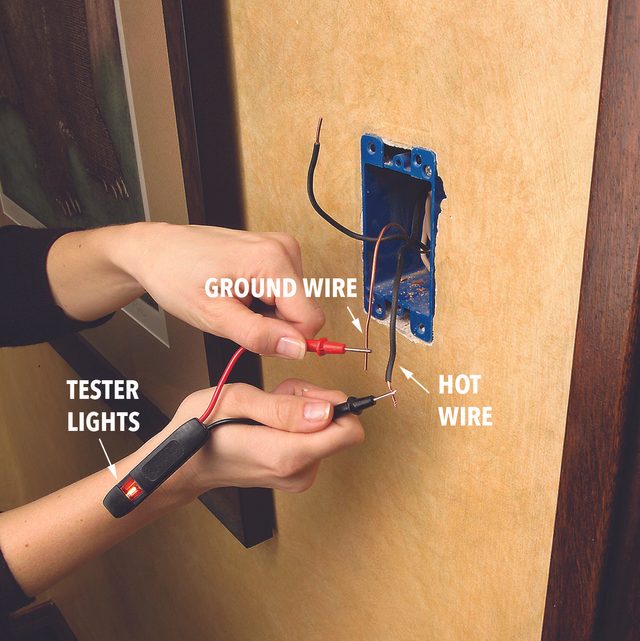
Step 9
Test Metal Boxes
- Examination whether a metallic box is grounded by using the aforementioned procedure equally above.
- Impact the metal box instead of the footing wire with the 2nd pb.
- Note: If the tester lights up, the box is grounded.
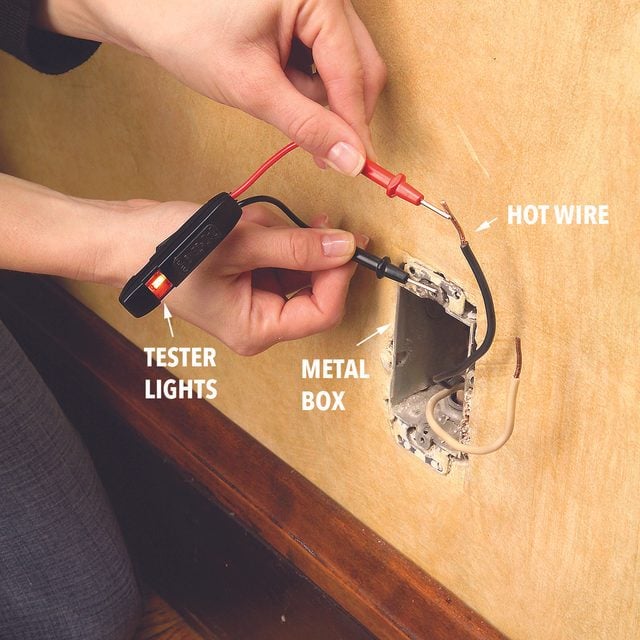
More on Using a Two-Lead Circuit Tester
The ii-lead excursion tester shown here besides tests for voltage. When you impact a live hot wire (black or any other color except green and white) with one lead and a neutral (white) or ground (green or bare copper) with the other, the neon test lamp should light. Information technology confirms that the power is on and that yous have a complete (adept) circuit. If the light doesn't come on, either the ability is off or you lot have a bad circuit.
This tool comes in especially handy in older homes when you desire to know if an equipment basis wire (green insulated or bare copper) is actually continued to ground elsewhere in the organisation.
Yous ofttimes accept to cheque this when y'all supplant older ungrounded switches with grounded ones equally now required by the National Electrical Code. You ofttimes notice an unused bare ground wire folded back into the box, and you lot take to test it to make sure that it'southward connected to the rest of the grounding system before hooking upwards your new switch.
Circumspection: Avoid touching a live hot wire and don't allow it touch anything else. Agree the tester leads past the insulated portion while making contact. And plough the circuit off again as soon as yous finish the test.
Step x
Utilize a Continuity Tester to Identify Wires and Test Switches
- This is a safe tool that allows you to trace wiring and test switches.
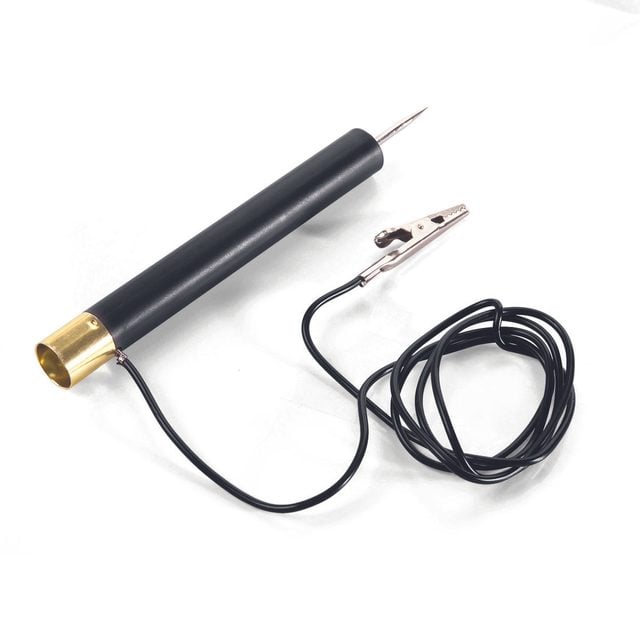
Step 11
Identify Remote Wires
- Attach the clip to the wire and probe other wires with the pointed end until the tester lights.
- Note: The electrical ability should be off.
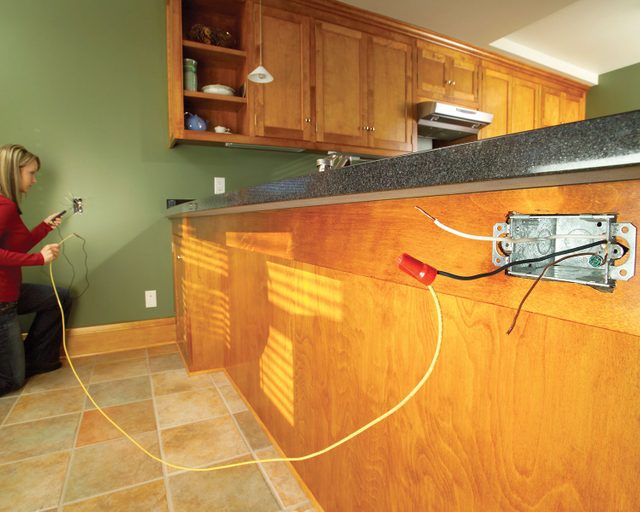
Step 12
Use a Test Wire
- Clip the pb to the test wire.
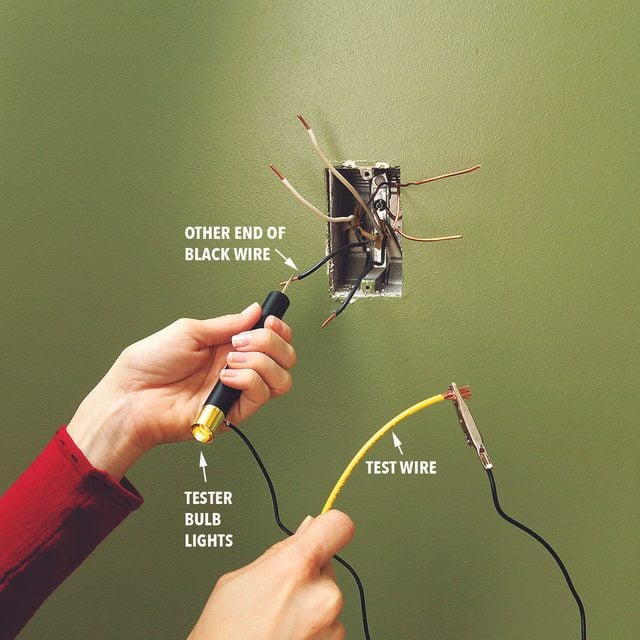
Step 13
Test Switches
- Remove the switch.
- Clip one atomic number 82 to one switch concluding.
- Touch the point to the other terminal and flip the switch on and off.
- Note: The tester light will go on and off if the switch is adept.

It's difficult and unsafe to trace the routes of diverse wires with circuits turned on. A continuity tester does it simply and safely with the circuits turned off. It has a probe, which contains a bombardment and a light bulb, and a wire lead. When yous touch the ends to whatsoever continuous conductive path, commonly a wire, with both the probe and the pb, a circuit will be consummate and the bulb will light. In fact, to test the bulb to make sure it'due south working, merely affect the pb to the probe.
Working with several boxes and tin can't remember which wire goes where? With the power shut off, only connect a exam wire to a circuit wire in one box, prune the lead to the examination wire and bear upon the probe to the ends of the circuit wires in the other box. The seedling volition calorie-free when you detect the correct wire.
Another neat employ for the circuit tester is to determine whether a switch is working. Disconnect the switch, connect 1 lead to one final and put the probe on the other while y'all flick the switch on and off. If the switch is expert, the seedling should light up and turn off besides.
CAUTION: If you take aluminum wiring, don't mess with it. Call in a licensed pro who's certified to work with it. This wiring is dull grey, non the dull orangish that's characteristic of copper.
Originally Published: November 23, 2020
Source: https://www.familyhandyman.com/project/how-to-use-cheap-electrical-testers/

0 Response to "How To Use Sperry Voltage Tester"
Post a Comment